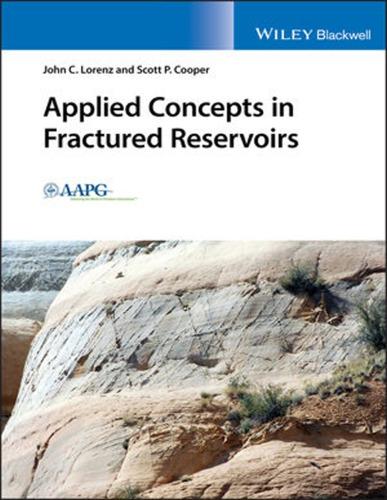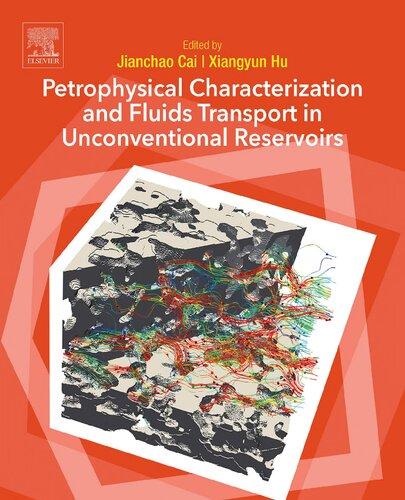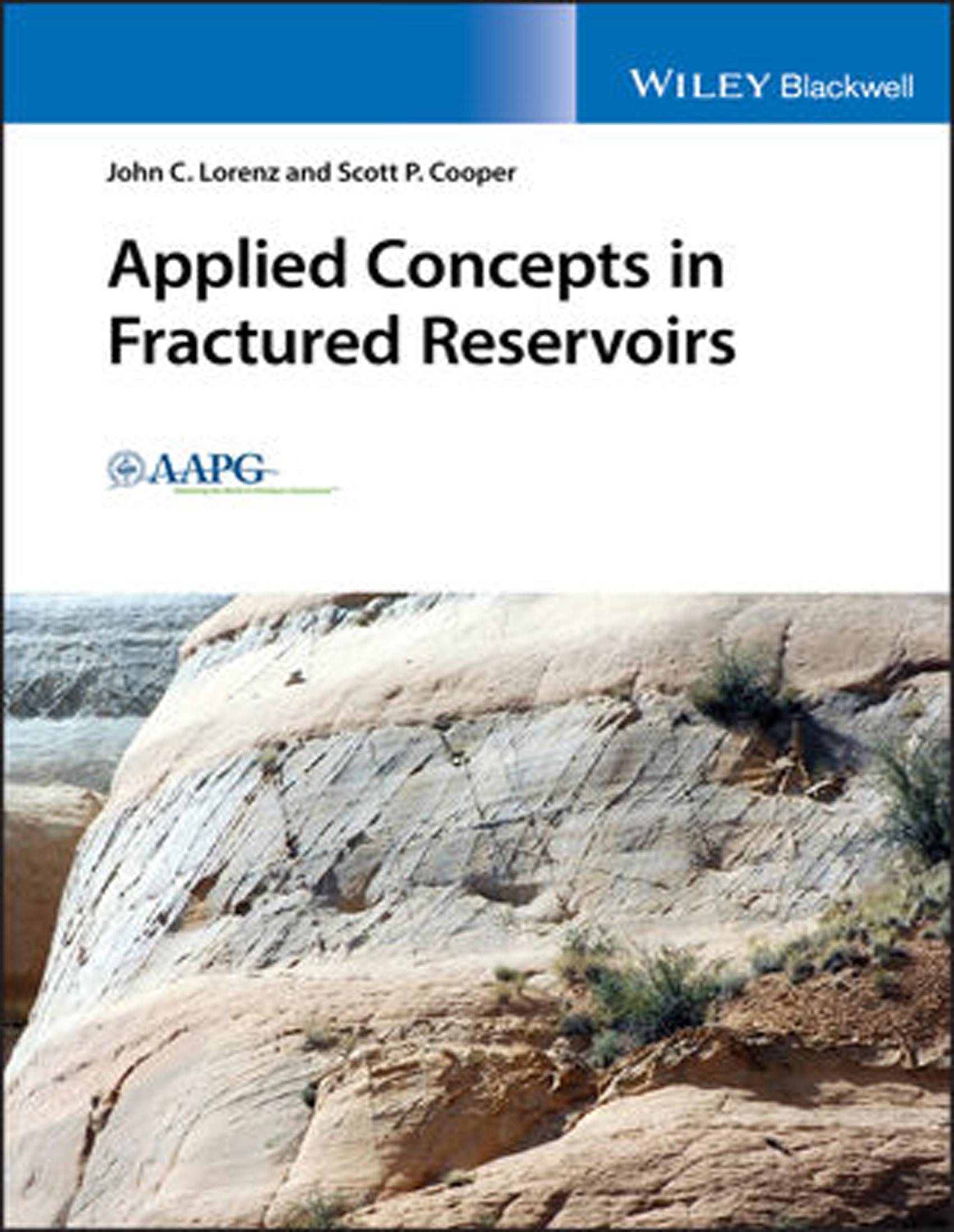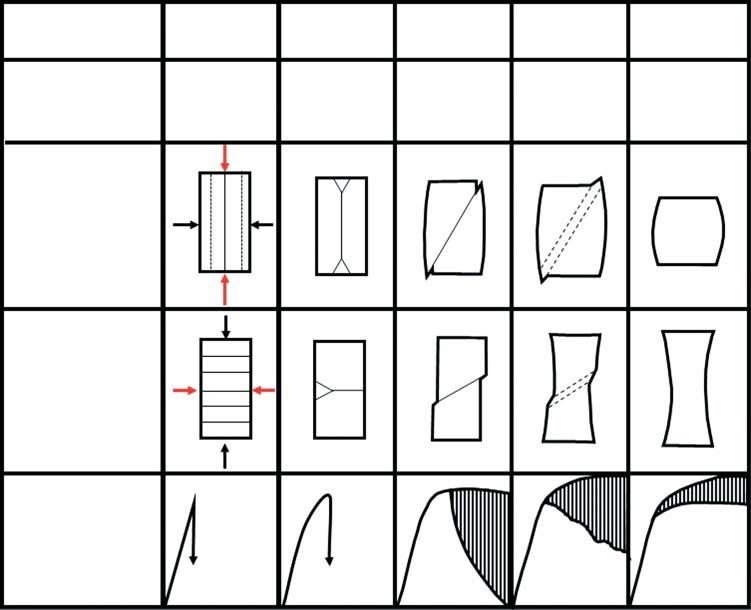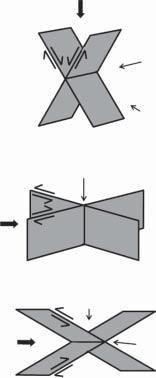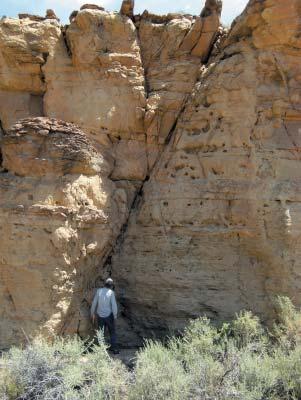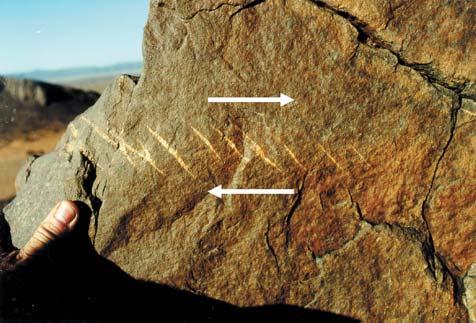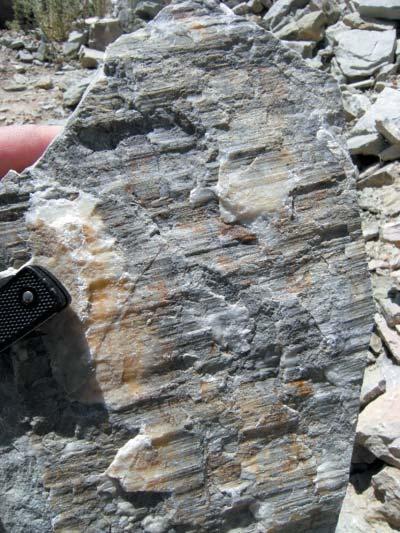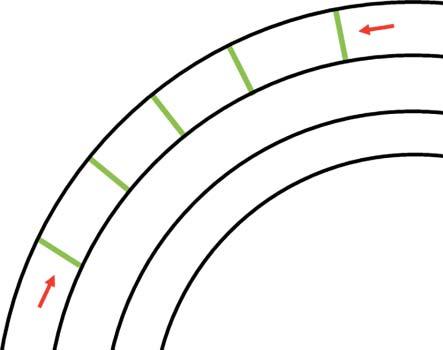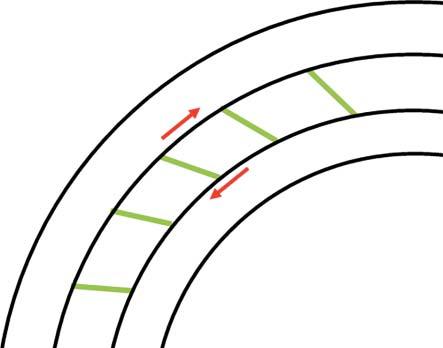AppliedConceptsinFracturedReservoirs
JohnC.Lorenz
FractureStudiesLLC
NewMexico,USA
ScottP.Cooper
FractureStudiesLLC
NewMexico,USA
Thiseditionfirstpublished2020 ©2020JohnWiley&Sons,Ltd
Allrightsreserved.Nopartofthispublicationmaybereproduced,storedinaretrievalsystem,ortransmitted,inanyformorbyanymeans, electronic,mechanical,photocopying,recordingorotherwise,exceptaspermittedbylaw.Adviceonhowtoobtainpermissiontoreusematerial fromthistitleisavailableathttp://www.wiley.com/go/permissions.
TherightofJohnC.LorenzandScottP.Coopertobeidentifiedastheauthorsofthisworkhasbeenassertedinaccordancewithlaw.
RegisteredOffice
JohnWiley&SonsLtd,TheAtrium,SouthernGate,Chichester,WestSussex,PO198SQ,UK
EditorialOffice 9600GarsingtonRoad,Oxford,OX42DQ,UK
Fordetailsofourglobaleditorialoffices,customerservices,andmoreinformationaboutWileyproductsvisitusatwww.wiley.com.
Wileyalsopublishesitsbooksinavarietyofelectronicformatsandbyprint-on-demand.Somecontentthatappearsinstandardprintversionsof thisbookmaynotbeavailableinotherformats.
LimitofLiability/DisclaimerofWarranty
Whilethepublisherandauthorshaveusedtheirbesteffortsinpreparingthiswork,theymakenorepresentationsorwarrantieswithrespecttothe accuracyorcompletenessofthecontentsofthisworkandspecificallydisclaimallwarranties,includingwithoutlimitationanyimpliedwarranties ofmerchantabilityorfitnessforaparticularpurpose.Nowarrantymaybecreatedorextendedbysalesrepresentatives,writtensalesmaterialsor promotionalstatementsforthiswork.Thefactthatanorganization,website,orproductisreferredtointhisworkasacitationand/orpotential sourceoffurtherinformationdoesnotmeanthatthepublisherandauthorsendorsetheinformationorservicestheorganization,website,or productmayprovideorrecommendationsitmaymake.Thisworkissoldwiththeunderstandingthatthepublisherisnotengagedinrendering professionalservices.Theadviceandstrategiescontainedhereinmaynotbesuitableforyoursituation.Youshouldconsultwithaspecialistwhere appropriate.Further,readersshouldbeawarethatwebsiteslistedinthisworkmayhavechangedordisappearedbetweenwhenthisworkwas writtenandwhenitisread.Neitherthepublishernorauthorsshallbeliableforanylossofprofitoranyothercommercialdamages,includingbut notlimitedtospecial,incidental,consequential,orotherdamages.
LibraryofCongressCataloging-in-Publicationdatahasbeenappliedfor ISBN:9781119055860[hardback]
CoverDesign:Wiley
CoverImage:©JohnC.LorenzandScottP.Cooper
Setin10/12ptWarnockProbySPiGlobal,Chennai,India 10987654321
Formyfamilyandmentors;MomandDad,Sean,Ryan,Karen,John,Alvis,andLaurel.Ithasbeenanamazing journey,Thanks!
ScottP.Cooper
ForNancyandNed,MargaretandNorman,whowerepartofagenerationwithideals,principles,andanappreciation forcriticalthinking;andforAlexwhoarrivedlater.
JohnC.Lorenz
Contents
Foreword xi
Preface xiii
Acknowledgements xv
Introduction xvii
PART1UnderstandingNaturalFractures:FractureTypes,Dimensions,andOrigin 1
1.1Introduction 1
1.2NomenclatureandFracture-ClassificationSystems 1
1.2.1Introduction 1
1.2.2OtherClassificationSystems 3
1.2.3ClassificationsforFracturesinOutcropsandCores 4
1.2.4ExpulsionFracturesandNaturalHydraulicFractures 5
1.2.5OtherFractureTerminology 5
1.2.6Sets,Systems,Domains,andSystematicFractures 7
1.3FractureCharacteristicsandDimensions 8
1.3.1Introduction 8
1.3.2FractureDistributionPatterns 8
1.3.3Fractography 10
1.3.4FractureDipAngles 13
1.3.5FractureDistributions 13
1.3.6FractureHeightsandTerminations 16
1.3.7FractureLengths 18
1.3.8FractureWidths,Apertures,andMineralization 19
1.3.9FractureSpacing 22
1.3.10FractureStrike 27
1.3.10.1FractureOrientationsRelativetotheInSituStresses 28
1.3.11Discussion 28
1.4TheMechanicsofFracturingRockinExtensionandShear 29
1.4.1Introduction 29
1.4.2OriginsofGeologicStressSystems 31
1.4.2.1StressesinaTectonicallyQuiescentBasin 31
1.4.2.2OtherPotentialSourcesofHorizontallyIsotropicStress 32
1.4.2.3StressesinaTectonicallyActiveBasin 32
1.4.3RockSusceptibilitytoFracture:BasicConcepts 35
1.4.3.1Introduction 35
1.4.3.2IntrinsicControlsonFractureSusceptibility 38
1.4.3.3ExtrinsicControlsonFractureSusceptibility 39
1.4.3.4HowRockBreaks:Grain-ScaleCracking,Yield,andFailure 41
1.4.3.5ExtrapolationtotheSubsurface 43
1.4.4InterplayBetweenDevelopingFracturesandtheInSituStresses 44
1.4.5TheImportanceofPorePressure 45
1.4.5.1Introduction 45
1.4.5.2TheRelationshipbetweenPorePressureandStress 45
1.4.5.3Biot’sCoefficient 47
1.4.5.4MohrDiagramsandPorePressure 47
1.4.5.5PorePressureMakesRockWeakandBrittle 47
1.4.5.6SourcesofPorePressure 50
1.4.5.7AlternateTheories 51
1.4.6Summary 52
1.5OtherFractureTypes 53
1.5.1Introduction 53
1.5.2Deformation-BandShearFractures,CompactionBands,and DilationBands 53
1.5.2.1GeneralCharacteristics 53
1.5.2.2DimensionsandDistributions 53
1.5.2.3Origin 54
1.5.3FaultsandFractures 55
1.5.4Microfractures 56
1.5.5StylolitesandAssociatedExtensionFractures 59
1.5.6Bed-ParallelShearFractures 59
1.5.7Beef-FilledFractures 62
1.5.8PtygmaticallyFoldedFractures 63
1.5.9AlterationofFractureSystemsbyDissolution 64
APPENDIX1.ATheRelationshipBetweenPorePressureandtheInSituEffectiveStresses 66
Introduction 66
VerticalStress 67
HorizontalStress 67
EffectiveVerticalStress 67
EffectiveHorizontalStress 68
StressDifferential 68
PART2MeasuringandAnalyzingFracturesinReservoirs 71
2.1Introduction 71
2.1.1ReasonstoTakeCore 72
2.1.2Analyses 73
2.1.3FractureDataSources 73
2.1.4Quantitativevs.Semi-QuantitativeData 73
2.1.5TimingofaFractureStudy 73
2.1.6NeedforExperience 74
2.1.7OtherDataSources 74
2.2PlanningaCoreProgramforFractureAnalysis 74
2.2.1Introduction 74
2.2.2CoreDiameterandLength 74
2.2.3SubstitutingSidewallCoreSamples 74
2.2.4OrientingaCore 74
2.2.5DrillingParameters 75
2.2.6TripTimeforCoreRecovery 75
2.2.7CollectingDataonSite 75
2.2.8RunninganImageLog 76
2.2.9Back-to-BackCores 76
2.2.10On-SiteProcessing 76
2.2.11CTScans 77
2.2.12RemovingCorefromtheBarrel 77
2.2.13Core-JamPreventionMeasures 77
2.2.14MaximizingandDocumentingCoreContinuity 77
2.2.15SlabbingProtocol 77
2.2.16SchedulingFractureLoggingandotherCoreProcesses 78
2.3LoggingCoreforFractures 78
2.3.1WashtheCore! 78
2.3.2UsealltheCoreandRemoveitfromtheCoreBoxes 79
2.3.3LayingOutIntervalsofCoreforFractureLogging 79
2.3.4Core-LoggingToolkit 80
2.3.5RecordingData 81
2.3.6MakingandUsingaMasterOrientationLine 82
2.3.7DifferentiatingNaturalfromInducedFractures 83
2.4Taking,MeasuringandAnalyzingFractureData 84
2.4.1FractureType 84
2.4.2FractureDepths:IntensityandDensity 86
2.4.3FractureDipAngles 88
2.4.3.1MeasuringDipAngles 88
2.4.3.2UsingDipAngles 89
2.4.4FractureDistributions 90
2.4.5FractureHeightsandTerminations 91
2.4.6FractureWidths,Apertures,andMineralization 94
2.4.7FractureSpacings 98
2.4.7.1SpacingsfromHorizontalCore 99
2.4.7.2SpacingsfromVerticalCore 103
2.4.7.3ConvertingVerticalObservationstoHorizontalFractureSpacings 103
2.4.7.4SpacingsofInclinedandShearFractures 105
2.4.7.5UsesofSpacings 105
2.4.8MeasuringandUsingFractureStrikes 105
2.4.8.1MeasuringFractureStrikesinVerticalCore 106
2.4.8.2MeasuringFractureStrikesinDeviatedorHorizontalCores 109
2.5NewCorevs.ArchivedCore 110
2.6OrientedCore 112
2.6.1OtherWaysofOrientingaCore 116
2.7UsingCTScans 118
2.8FractureDatafromImageLogs 119
2.9ComparingFractureDatafromOutcrops,Core,andLogs 122
2.9.1Introduction 122
2.9.2Large-ScaleOutcropStudies 123
2.9.3LocalOutcropStudies 123
2.9.3.1RatonBasin 123
2.9.3.2RifleGap 125
2.9.3.3SanYsidro 127
2.10FractureDatafrom3DSeismicSurveys 128
2.11FractureDataAcquiredbyLiDAR 130
2.12FractureDatafromEngineeringTests 132
2.13CaseStudiesinEstimatingFractureEffectivenessfromCore 133
2.13.1Introduction 133
2.13.2CaseStudy1:ArchivedVertical,UnorientedCore 133
2.13.3CaseStudy2:New,Un-SlabbedHorizontalCore 134
2.13.3.1Introduction 134
2.13.3.2FractureEffectiveness 137
2.13.3.3SystemEffectivenessandPermeabilityAnisotropy 137
2.13.4CaseStudy3:New,Slabbed,VerticalCore 139
2.13.4.1Introduction 139
2.13.4.2CalculatingEffectiveness 139
2.13.4.3DescriptionoftheHigh-AngleExtensionFractures 141
APPENDIX2.AWorkflowandListofTests,Data 144
APPENDIX2.BCore-Handling,Marking,Sampling,andAnalysisProtocolforCoreStudiesFocused onNaturalFractures 144
APPENDIX2.CSlabbingRecommendationsforHorizontalCore 146
PART3EffectsofNaturalFracturesonReservoirs 149
3.1Introduction 149
3.2Classification 149
3.3ThePermeabilityBehaviorofIndividualFractures 150
3.3.1Introduction 150
3.3.2ThreeCategoriesofFractureEffects 150
3.3.3Stylolites 154
3.3.4Microfractures 154
3.4TheEffectsofFractureSystems 156
3.4.1Introduction 156
3.4.2Fracture-ControlledPermeabilityAnisotropy 157
3.4.2.1CaseStudy:TheMidaleField 157
3.4.2.2CaseStudy:TheRulisonField 158
3.4.2.3CaseStudy:TheSpraberryFormation 158
3.4.3Fracture-ControlledSweetSpots 162
3.5TheSensitivityofFracturePermeabilitytoChangingStress 164
3.5.1Stress-SensitiveExtensionFractures 164
3.5.1.1CaseStudy:TheBuloBuloField 167
3.5.2Stress-SensitiveShearFractures 169
3.5.3DamageDuetoProduction-RelatedScale 171
3.6FractureVolumetrics 172
3.6.1Introduction 172
3.6.2FractureVolume/FracturePorosity 173
3.6.3FracturePermeability 174
3.6.4TransferFunction 176
3.6.5FractureSurfaceAreas 176
3.7EffectsofFracturesonDrillingandCoring 177
3.8Completions:TheInteractionBetweenNaturalandHydraulicFractures 178
3.8.1EarlyConceptualModels 178
3.8.2DirectEvidenceoftheCharacteristicsofHydraulicFractures 179
3.8.3TheDevelopingHydraulic-FractureModel 182
3.8.4NuclearStimulations 184
References 187 Index 205
Foreword
AppliedConceptsinFracturedReservoirs isamuchneededpreciseandpracticaltreatmentofakeytopicin theenergyindustryandbeyond.Thesubjectofnatural fracturesandtheirimpactonhydrocarbonreservoirs hasbeenamutualinterestthatIhavesharedwiththe seniorauthorofthisbook,JohnLorenz,fordecades.In myviewthiswillbecomeastandardreferenceforgeoscientistsandengineersworkingonfracturedreservoirs, forexamplereservoirengineers,geophysicists,geologists,androckmechanicspractitioners.Itwilltakeits placeamongthemanyotherpublicationsbytheauthors alreadyaddressingrelatedissues.Theimportanceofthe bookliesinthefactthatitaddresseswhatisprobablythe mostpervasivefeatureofrocks:thetendencytobreak undernaturalorman-madestresses.Theauthorsput thisinanappliedcontextforallinvolvedinexploration anddevelopmentintheindustryandinacademia.In thatcontextthebookiswellorganizedandclearlyillustratedinaneasytograspcollectionofapplicationsfor fracturestudies,forexampletheirimpactonreservoir petrophysics,theirinfluenceondrilling,andproduction engineering.
Thebookisbalancedinthatitintroducesthereader tobasicdefinitionsandclassificationsoffracturesand fracturedreservoirsattheoutset.Itthenproceedsby
outliningaworkflowforfracturedreservoirscharacterizationanditgoesontointroducethewayfractures impactoperationalactivities.Thebookallocatesa considerablesectiontodiscussingtheimpactofnaturalfracturesonhydraulicfracturing.Inmyopinion suchimpactisnotfullyunderstoodandincludingit inthebookisatimelyapproachtoraisequestions, stimulatethoughts,andshedsomelightondifferent experimentalexplanations.Theabilitytopredictthe outcomewhennaturalfracturesinteractwithhydraulicallystimulated/inducedfracturesinareservoirisa challengenotyetfullyachieved.Advancementinthis areaofhydrofracturingisacrucialstepinmaking hydrofracturingmoreefficientandsafer.
JohnLorenzandScottCooper,whoareaccomplished researchersandconsultants,haveproducedavaluable resourceonthesubjectoffracturedreservoirs,apublicationwhichcomplementsprevioustexts,andtakesthe topictoabroader,up-to-date,appliedlevelandscope.
MohammedS.Ameen(Ph.D.,DIC,FGS) PrincipalProfessionalinGeomechanics, EmergingUnconventionalAssetsDepartment, SaudiAramco,Dhahran,SaudiArabia
Preface
Thisbookisacompaniontoourprevious Atlasof NaturalandInducedFracturesinCore,movingonfrom thebasicrecognitionoffracturetypesdescribedinthat volume,whichmustbethefoundationofanyfracture study,toexplanationsofhowthosefracturesform,how theyaremeasured,howtheycanbeassessed,andhow theyaffectreservoirs.
Thisvolumeisthesummaryofdecadesofexperience withindustrydoingappliedfracturestudies.Itbrings
togethernumerousfracture-relatedtopicsthatarenot collectedelsewhere.Wehopethatitwillbeusefulto bothacademiaandindustry,andthatitisnotinthevein oftheapocryphalthird-graderdoingabookreporton penguins,whoconcludedthat“Thisbooktellsmemore thanIwanttoknowaboutpenguins.”
Acknowledgements
Numerouspeoplehavecontributedtothiseffort, providingreviews,materials,references,photographs, andinsights.Wewouldspecificallyliketoacknowledge andthankMohammedAmeen,BruceHart,Connie Hawkins,NateGilbertson,RonNelson,AhmedOuenes, DavidSchechter,JoeSimonson,andNormWarpinski.
Muchoftheoriginalmaterialusedtoillustratethis volumehascomefromdetailed,unpublishedindustry studies,andwethankthosecompaniesforallowing
ustousethematerial,sanitizedforpublication.We wouldalsoliketoacknowledgealloftheastutepeople whoovertheyearshaveworkedinthisamazingfieldof studyandwhosepublishedpaperswereusedthroughout thistext.
Wewouldalsoliketothankourwives,who,knowing betterthanwedidthesizeoftheundertaking,said“Sure, whynot?”whenaskedifwemightcarvetheneededtime fromfamilycommitments.
Introduction
Onecan’tbegintowriteatextbookwithoutselfindulgentlyexplaininghowimportantthesubjectmatter isandhowreadersthereforeabsolutelyneedtoknow thematerial.Fortunately,theimportanceofunderstandingtheorigins,characteristics,andeffectsofnatural fracturesinhydrocarbonreservoirsisbecomingwidely accepted,soitisenoughforustonotethattechnology hascontinuedtoextendarecognitionofthepresence andimportanceofnaturalfracturesinmanyreservoirs oncethoughttobeun-fractured.Moreover,theincreasinguseofhorizontalanddeviatedwellboresisproviding uniqueandinvaluableinformationontheclosefracture spacingsexhibitedbymanyfracturesystems,evenin relativelyundeformedstrata.
Itwasnotalwaysso.Thedefaultconceptualmodelof areservoirbeforeimagelogsandextensivecoring,even indeformedstrata,rarelyincludednaturalfractures,and therewerefewdatapointstoindicateotherwise.Cored fracturesusedtoberelativelyrarebecauseofthewide fracturespacingstypicalofthethickerreservoirunits mostcommonlycored,andbecauseverticalcorehasa lowprobabilityofcapturingverticalfractures,themost commontypeinmanyreservoirs.Forexample,avertical, 4-inch(10cm)diametercorecutverticallythrougha fracturedbedwherefracturespacingaverages40inches (about1m)hasonlya10%probabilityofsamplingthe fracturepopulation(seeLorenz,1992).Theabsenceof verticalfracturesinverticalcoreusedtobeacceptedas proofthatareservoirwasnotfractured,butthatislike sayingthattherearenomosquitosaboutonasummer’s eveningpicnicbecauseyouhavenotbeenbittenyet.
Thisabsenceofgoodsubsurfacedata,andtheslowly maturingstudyofgeomechanicspriortothe1980s,did notsupportthepresenceoffracturesinthesubsurface belowabout2000ft.Statementssuchas“Atdepth mostjointsaregenerallyclosed ”(Heck,1955)were widelyaccepted,andeventheexpertsattherespected rockmechanicslaboratoryoftheExplorationand ProductionResearchDivisionoftheShellDevelopment Companywouldwritethat“Itis,ofcourse,inconceivable thatanopencrackcouldexistatdepth…”(Griggsand Handin,1960).Thus,thosefracturesthat were cored
wereusuallyconsideredtobeexceptionsratherthan,as theyare,evidenceforabundantfracturing.
Substantive,definitivedatanowdocumentthecommonpresenceofnaturalfractureswithsignificant, permeability-enhancingaperturesatthedepthsofhydrocarbonreservoirs.Moreover,improvedunderstandings ofgeomechanicsandthedynamicsofreservoirs(e.g., Ameen,2018)haveallowedforpredictionsofthebehavioroffracture-permeabilitysystemsduringproduction. Thus,theeffectsofnaturalfracturesmustbeincluded inassessmentsofmostreservoirpermeabilitysystems, especiallyinunconventionalreservoirs.
Thedefaultconceptualnaturalfractureinearlyreservoirmodelswasaregularlyspaced,randomlyoriented, openslotofuniformwidth.Therealityisthatthefracturesofatypicalfracturesetinahydrocarbonreservoir arelog-normallyspaced,systematicallyoriented,and haveirregularapertures.Althoughasignificantvariety offracturetypesexistinhydrocarbonreservoirs(see LorenzandCooper,2018a),theireffectsonpermeability canbereasonablyassessedifthefracturetype,degreeof occlusion,degreeofdevelopment,andtectonicsetting canbecharacterized.
Forexample;shearfracturescommonlyoccuras related,intersectingconjugatepairswhereasextension fracturesoccuraspoorly-connectedparallelplanes. Shearfracturesformverticallyandlaterallyinterconnecteddrainagenetworksbuttheindividualshearfractureaperturesandthereforepermeabilitiesare irregular.Incontrast,setsofextensionfracturescreate highlyanisotropicdrainageinareservoir,andarelikely tobeverticallylimitedbylithologicdiscontinuities. Thus,itisimportanttonotonlyrecognizethepresence offracturesinareservoirbutalsotobothcorrectly identifythefracturesbytypeandtofullycharacterize them.Fracturesinareservoirmustbeunderstood,they cannotbemerelycountedandoriented.
Correctfractureidentificationsandcharacterizationsallowthegeologist,modeler,andengineertobe accurateinspottingwelllocationsanddesigninghorizontalwellboreazimuths.Thesedataprovideanchor pointsforseismicandpetrophysicalinterpretations
aswellasbasicdataforreasonabledeterminationsof fracture-systemvolumetricsincludingporosity,permeability,reserves,recoveryfactors,andproductionrates. Accurateknowledgeoffracturesystemsallowsengineerstodesignappropriatecompletionandproduction strategies,takingadvantageoforatleastaccommodatingfracture-controlleddrainageanisotropyand stress-sensitivepermeabilities.Suchin-depthknowledge allowsthepetrophysicisttomoreaccuratelyinterpret imagelogs.
Thisvolumeisacompanionvolumetoourearlier AtlasofNaturalandInducedFracturesinCore (Lorenz andCooper,2018a).Thatvolumeprovidesatoolfor accuratelyidentifyingdifferentfracturetypeswhereas thisvolumediscusseshowthedifferenttypesformed, andhowtheyaffectreservoirvolumetrics.Thepresent volumeisdividedintothreesections.Part1, UnderstandingNaturalFractures:FractureTypes,Dimensions, andOrigins,discussestheorigin,thecharacteristics, thevariationsamong,anddistinctionsbetweenextensionfracturesandshearfractures.Italsodescribes microfractures,fracturesassociatedwithfaults,the effectsofthedifferentgeomechanicalpropertiesof differentlithologiesonfracturedevelopment,fracture domains,andfracturecorridors.Theimportantmineralizationthatcanoccludefractureaperturesand reducefracturepermeability,aswellasthedissolution thatcanenhanceit,areincludedinthediscussions. Thecharacteristicsofbothindividualfractures(length, widths,heights,apertures)andfracturepopulations (spacings,interconnectivity)ofdifferentfracturetypes aredescribed.
Part2, MeasuringandAnalyzingFracturesinaReservoir ,dealswithtechniquesforloggingandobtaining themaximumamountofdatafromcores.Itincludes techniquesfordistinguishingnaturalfrominduced fractures,anddiscussesthepotentialusesofdifferent kindsofinducedfracturesindeterminingtheinsitu stressorientationsaswellasindeterminingtheorientationsoffracturesrelativetothestressesandtoeach other.Wedescribetheprosandconsoforientedcore andtechniquesforquality-checkingacore-orientation survey,aswellastechniquesforfractureanalysisonce thefracturedatahavebeencollected.Includedinthis sectionaretheexpressionsoffracturesinimagelogsand theadvantagesofcorrelatingimagelogstocores,noting thesignificantlyincreasedvalueofboththeimagelog onceithasbeencalibratedtocore,andofacorethathas beenorientedusinganimagelog.
Part2alsoofferstheobservationthatthereareseveral validfold-relatedfracturemodels,eachappropriateto
oneofthedifferentmechanismsforfoldingstrata,suggestingthatthereisnouniversalmodelthatdescribes fracturedistributionsandorientationsonanticlines.In addition,wewilldescribethepotentialdistributionsof fracturesalongwrenchfaultsandwithinfoldandthrust belts.
Part3describes EffectsofNaturalFracturesonReservoirs,offeringtechniquesforestimatingvolumetricsin fracturedreservoirs,anddiscussingthefracture-related enhancementand/ordegradationofreservoirpermeability.Thissectionwilldescribedifferencesinthe potentialsofdifferentfracturesystemstocreatedrainage andpermeabilityanisotropyinareservoir.Wealsoillustratethechangesinthefracture-relatedpermeabilitythat canbecausedwhenfractureaperturesnarrowduring changesinreservoirfluidpressuresandtherelatedeffectivestressesduringproduction.Aseriesofwellsdrilled intoafracturedreservoirtendstohavenon-uniform productionratesandrecoveries,sotheeffectsoffracturecorridorsanddomainsincreatingreservoirsweet spotsarediscussed.Finally,wewilladdresstheissue ofinteractionsbetweennaturalfracturesandhydraulic stimulationfractures.
Theprimaryliteratureonnaturalfracturesisvast andvaried,andisrepletewithinconsistenciesand conflictinghypotheses.Thereareadozengood,basic structural-geologytextbooks(e.g.Fossen,2010;Pollard andFletcher,2005;Mandl,2005;NationalResearch Council,1996;TwissandMoores,1992)thatdescribe naturalfracturesandthemechanicsoffracturingrock, buteventhesesummariesarenotintotalagreement. Itisinterestingtocomparethevarietyofconcepts,terminology,andinterpretationsofferedinthesetexts(see forexampleLorenzandCooper,2019),andtocompare thedifferentexperimental,theoretical,andempirical approachesauthorshaveusedindescribing,assessing, andinterpretingnaturalfractures.Significantlyfewer texts(e.g.Nelson,2001;NationalResearchCouncil, 1996;Narretal.,2006)havefocusedonfracturesand theireffectsonhydrocarbonreservoirs.
Inwritingatextbook,authorspresumethattheyknow somethingthatthereadersalsoreallyneedtoknow,or thattheauthorshaveadifferentandvaluableperspective, orthattheycancapturetheessenceofabodyofliterature andcondenseitintoausefulpackage.Wehopethatwe havedoneallthree,andthatourexperiencehasallowed ustobuildontheimportantconceptsandinformation presentedinearlierworks,todistillthem,andtofindthe usefulcommonalities.
PART1
UnderstandingNaturalFractures:FractureTypes,Dimensions,andOrigin
1.1Introduction
Webeginthistextwithashortdiscussionofbasic fracturenomenclatureinordertoprovideacommon understandingandframeworkfortherestofthevolume. Nomenclaturewouldseemtobearatherstodgylead-off topic,butthewhiplashprovidedbythevarietyoffractureterminologyintheliterature(e.g.PollardandAydin, 1988;LorenzandCooper,2019)shouldpreventthe discussionfrombeingoverlydullandboring.Anomenclaturediscussionprovidesabasisformeldingdata, observations,andconceptsfromthelaboratory,outcrops,andtheory,aswellasforfollowingthearguments ofpaperswrittenbydifferentauthors.
Allfracturetypesdonothaveequaleffectsona reservoir,sothenomenclaturesectionisfollowedby descriptionsoftherangeoffracturedimensionsandby illustrationsofthecharacteristicsthatmustbeaccounted forwhenattemptingtomodelfluidflowthroughanaturallyfracturedreservoir.Thisdiscussionfocusesonshear andextensionfractures,whicharethemostcommon fracturetypesinhydrocarbonreservoirs,butitwill includesomeoftheotherkindsoffracturesfoundin reservoirs.Wewillalsoexplorethebasicmechanicsof fracturingrockinshearandextensionsincethatknowledgeisusefulinextrapolatingthelimitedfracturedata obtainedfromawellboreintothethree-dimensional volumeofthereservoir,andcansometimesbeusedto inferthecharacteristicsoreventhepresence/absenceof fracturesystemsinareservoirpriortodrilling.
Fracturecharacteristicsdependonthestressconditionsatthetimeoffracturingaswellasthemechanical propertiesofthehostrock,whichinturndependson thebasiccomposition,sedimentaryheterogeneity,and diagenetichistoryoftherock.Therefore,wewilldiscuss thevariationsoffracturecharacteristicsascontrolledby lithology,principallythegross-scaledifferencesinherentinfracturinglimestone,sandstone,andshaleor mudrock.Wewillalsoexaminewhathappenswhen afractureformswithinonestresssystemandislater reactivatedwithinareorganizedstresssystem,forming acompoundfracture.
Openfractureaperturesinareservoirprovide high-permeabilitypathwaysthatcanbeenhanced bydissolutionand/orrestrictedbymineralization,so fractureaperturesandmodificationstofractureaperturesarealsodiscussed.Finally,theoriginsandeffects ofcloselyspacedfracturesinfracturecorridorsare examined.
Thesedescriptionsanddiscussionsfrom Part1 ofthis volumeandwillprovidethebasicunderstandingsnecessarytomoveonto Part2, MeasuringandAnalyzing FracturesinReservoirs,and Part3, TheEffectsofNatural FractureonReservoirs.
1.2Nomenclatureand Fracture-ClassificationSystems
1.2.1Introduction
Afractureisamechanicaldiscontinuityinarock, typicallyplanarandcommonlyassociatedwithaloss ofcohesionintherockacrossthefractureplane. Manyfracturesarefilledbypost-fracturingmineralization,restoringsomeorallcohesionacrossthefacture plane.Naturalfracturesarebrittletobrittle-ductile strain-accommodationstructuresthatdevelopwhenthe rockissubjectedtoastressanisotropygreaterthanits strength.
Thisdefinitioncoversanastonishingvarietyofstructures,andnumerousauthorshavedividedfractures intovariousclasseswithassortednamesineffortsto makesomesenseoutofthem.Classification,i.e.the identificationofpopulationswithinwhichthefractures havedistinctiveandsimilarcharacteristics,isthefirst stepinassessingfractureeffectsonareservoir,since allfracturetypesdonothavethesamepermeabilityor degreeofinterconnectedness.Nevertheless,it’suseful torememberthatmostclassificationschemes,including thoseforfractures,areartificialconstructs,andthe boundariesbetweenclassesarecommonlygradational ratherthanabrupt.



Figure1.1 Left :twocalcite-mineralizedverticalextension fracturescapturedbyacorecutfromamarinesandstone.The fracturesdonotintersectinthecorebuthaverelativestrikes(red bars)thatwillintersectinthereservoiroutsidethecorevolume. Upperright :asideviewofaninclinedshearfractureinthesame core. Lowerright :viewofthecalcite-mineralizedandslickenlined surfaceofthisshearfracture.5.25inch(13.3cm)diametercore; upholeistowardsthetopofallthreephotos.
Thefocusofthisvolumeison shearfractures and extensionfractures (Figure1.1).Extensionfractures formwhentheopposingfracturewallsmoveapart fromeachotherinthedirectionnormaltothefracture plane,whereasshearfracturesformwhentheopposing wallsmoveinoppositedirectionsbutparalleltothe fractureplane.Bothstructuresaccommodatestrainin abrittlefashionunderconditionsofanisotropicstress, andalthoughthereisagradationbetweenthesetwo basicfracturetypes,theyhavefundamentallydifferent characteristicsandthereforehavesignificantlydifferent effectsonreservoirs.Thesetwofracturetypescomprisethemajorityoffracturesfoundinhydrocarbon reservoirs.
Weprefernottonotusetheterms“joint,”anopen breakintherock,or“vein,”amineralizedjoint,since thetwotermsalwaysseemtogeneratediscussionand requiredefinitionduringdebatesontheoutcrop.Dictionariesinfactsuggestthattheterm“joint”comesfrom theverb tojoin, anditsoriginalconnotationreferred tothelocationwheretworockmassescometogether. Although“joint”mayhavehistoricalprecedence,“fracture”isperhapsmoreaptsincetherelatedverb to fracture appliesmoreappropriatelytotheoriginofthe
structureasabreakintherockmass.“Joint”and“vein” arebothtoobroad(notdistinguishingbetweenextensionandshear)andtoospecific(isamineralizedshear fractureavein?)tobewidelyuseful.Someauthors(e.g. Hancock,1985;Mandl,2005;Weijermars,1997)apply “joint”toanyfracturediscontinuityevenifithasshear offset;othersrestrictittothosefracturesthatdonot haveoffsetparalleltothefractureplaneandpreferthe term“fault”foranystructurewithindicationsofshear. Wehaveusedtheterm“vein”forearlydiageneticfilled fracturesthatareinsignificanttoreservoirpermeability(seeLorenzandCooper,2018a),andthetermalso adequatelydescribestheshort,wide,mineralized,en echelonstructuresfoundinshearzonesthatformin rocknearthebrittle-ductiletransition.However,“vein” doesnotservewellasagenericterm.
A“fracture”-basedlexiconissimpleandflexible.Itis easilymodifiedwithdescriptorstoindicateanyofthe numerousandimportantfracturecharacteristicssuchas modeoforigin,dipangle,andwhetherornotthefractureismineralized(i.e.an“inclined,calcite-mineralized shearfracture”),makingiteasytounderstand.Mostfracturetypesandmostothernomenclaturescanbefitinto afracture-basednomenclaturesystem(Table1.1).
Table1.1 Fracturenomenclatureasusedinthisvolume.
FractureClassificationsUsedinthisVolume
ModeofOrigin
Modifiers
Extension Mineralized,Unmineralized,andDissolution Dipangle:High,Intermediate,Low Bed-parallel Microfractures
Shear Mineralized,Unmineralized,andDissolution Dipangle:High,Intermediate,Low Normal,Reverse,andStrike-slip Bed-parallel Conjugate Microfractures
SpecialShearTypes
OtherTypes
Anticracks
Fissures
Veins
Expulsion
Ptygmatic
Beef-filled
Mixed-mode
DeformationBands Faults
EnEchelonTensionGashes
CompactionBands
Stylolites
1.2.2OtherClassificationSystems
Fractureclassificationscanalsobebasedonothercriteria,andawelterofclassificationsystemsthathavebeen usedfordifferentpurposesandindifferentcontexts existsintheliterature.Examinationofahalfdozen recentstructuralgeologytextbooksandthenumerous websitesandpublishedpapersshowssomeconsistency, severalconflicts,andafewjarringanomalies.Severalof thesesystemsaredescribedbrieflyheresothatastudent usingtheliteraturecanrecognizeandusethedifferences andcommonalities.
Petrophysicistswhocharacterizefracturesfromimage logsruninawellborecommonlyclassifyafracture signaturebyitselectricalcharacteristics,i.e.whether itis conductive or resistive.Theseelectricalproperties maybeusedtodeterminewhetherafracturehassome openwidth,whichinturncanbeusedtoassessfracture permeability,whichisultimatelywhywestudyfractures inhydrocarbonreservoirs.Servicecompanies,however,oftenleavethepermeabilityinterpretationstotheir client,recognizingthatitcanbeatrap.Forexample,conductivefracturesignatures,whichareusuallyinferred toindicatetheinvasionofdrillingmudintoopen fractureapertures,canalsoresultfromfracturesthat arecompletelyoccludedbutwherethemineralization includestracesofpyrite.Likewise,resistivesignatures canindicateeitherfracturesthatarelargelyoccluded bymineralization,deformation-bandshearfractures thatarenotmineralizedbutthatconsistofzonesof collapsedporosity,orfracturesthatarefilledwitha drillingmudthatisresistiverelativetotheformation fluidandlithology.
Nelson(2001)offersseveralfracture-classification types,includingonebasedlooselyonafracture’s morphologyanditspotentialeffectsonreservoirplumbing,thecategoriesincluding openfractures, deformed fractures, mineralizedfractures,and vuggyfractures. Otherauthors(e.g.Aguilera,2003)separatefractures intosystemsbasedontheirrelationshiptostructure, suchas tectonicfractures (primarilyshearfractures relatedtofaultsorfolds), regionalfractures (mostly extensionfracturesthatoccuroverwideareas),and surface-relatedfractures (fracturesrelatedtoweathering,spalling,stressrelease,andgravitationalforceson valleywalls).
Oneofthecommonfracture-classificationsystemsis basedonGriggsandHandin’s(1960)experimentson carefullymachined,centimeter-scalelaboratoryspecimens.TheirFigure1,reproducedhereasFigure1.2, showsaseriesofblockdiagramsrepresentingaprogressionfromextensionfracturestovarioustypesof shearfracturesastheductilityoftherockincreases,
allfracturingformedunderlaboratoryconditionsof tri-axialcompression.
Thisfigurehasbeenreproducedandmodifiedby numerousauthors,someaddingablockfor tensile fractures,formedundertruetension,ontheleftsideof thefigure,obscuringtheimportantdistinctionbetween tensionandextension.Althoughmostrockisanorderof magnitudeweakerintensionthanincompression,and althoughtensioniseasytocreateinthelaboratory,true tensionisrareinthesubsurfaceandisnotapplicableto theoriginofthenumerousandwidespreadextensionor shearfracturesinhydrocarbonreservoirs.
ItisimportanttorememberthatGriggsandHandin specifiedthattheirfigureillustratesaspectrumoffracturingratherthandiscretestages.Otherauthorshave addedtermsfortheintermediatestagesoffracturing betweenshearandextension,fracturesthatshowevidenceforbothextensionandshearoffset(i.e. hybrid , mixed-mode,or obliqueextension fractures;Ramseyand Chester,2004).
Theextensionfracturesthatformparalleltothe maximumappliedstressandnormaltotheminimum compressivestressduringtestsonGriggsandHandin’s mostbrittlerockshavebeencalled longitudinal-splitting , axialsplitting ,and cleavage fractures,orsometimes load-parallelextension fractures.Becausetheyoccur underconditionsofminimalconfiningstressthese structuresarenotalwaysconsideredtobeanalogousto subsurfacefractureswherethecompressiveconfining stresses,dictatedbytheweightoftheoverburdenand anyadditionaltectoniccompression,areassumedtobe significant.However,advancesingeomechanicsandan understandingofthesignificanteffectsofporepressure suggestthattheaxialsplittingextension-fractureprocesscanbeimportantinexplainingtheoriginofsetsof regionalextensionfractures.
Fracturesarealsocommonlydividedinto“Mode”categoriesbasedonorigin:
ModeI: extensionfractures
ModeII: shearfractureswhereshearwasparalleltothe fractureface
ModeIII: shearfracturesdistinguishedbyrotational shearalongthefractureface.ModeIII,rotationalshearfracturesarenotcommonintherockrecord andtheywouldbealmostimpossibletorecognize fromthelimiteddataavailableinthesubsurface,and wewillnotdiscussthemfurther.
TheModesystemissometimesextendedtoincludea ModeIV classofplanar, compaction or anti-crack structuressuchas stylolites and compactionbands,wherethe fracturewallsmovedtowardseachotherinadirection normaltothefractureplane,requiringvolumeloss.
Typicalstrainbefore fractureorfaulting (percent)
Typicalstressstraincurves
Figure1.2 Deformationincompressioninthelaboratory(fromGriggsandHandin,1960,theirFigure1).Theoriginalcaptionreads “Schematicrepresentationofthespectrumfrombrittlefracturetoductileflow,withtypicalstrainsbeforefractureandstress-straincurves foruniaxialcompressionandextension.Theruledportionsofthestress-straincurvesindicatethevariationwithineachcaseandthe overlapbetweencases3,4,and5.”Columns1and2showextensionfracturing,columns3and4showshearfracturing,andcolumn5 showsductiledeformation.GriggsandHandinlabeledthetoprowofsamples“Compression”andthesecondrow“Extension,”suggestive ofthetypeofdeformationimposedonthesamples.However,thatinvitesconfusionwiththedesignationofextensionfractures (columns1and2)vs.shearfractures(columns3and4),sowehaveomittedthoselabelsonthetworows.Alltestconditionswere compressive,asindicatedbytheformulaindicatingthestressconditions(σ)fordeformation:noneofthefractureswereformedintension, bypullingontheendsofthesamples.Notethattheangularrelationshipsbetweenthethreeimposedstressesandtheresultingfracture planesareidenticalinthetworowsofsamples,theonlydifferencebeingwhetherthemaximumcompressivestress(σ1 )wasimposed parallelornormaltothelongaxisofasample.(Theuseof σ todesignatestressinthisfigurefollowsGriggsandHandin’soriginalusage, whereaswehaveusedSforstressinmostofthistext,reserving σ todenoteeffectivestress.)
1.2.3ClassificationsforFracturesinOutcropsand Cores
Thenomenclatureusedforfracturesinoutcropsand incorescutfromthesubsurfaceissometimesdifferentfromthatusedinthelaboratory.Someauthors prefertouseadualnomenclatureinordertodistinguishoutcropfromlaboratorystructures.Forexample, althoughGriggsandHandinusedtheterm fault for laboratoryfracturesthatformedinshear,Jaegeretal. (2007)use fault forshearstructuresinoutcropand shearfracture forsimilarstructuresformedinthelaboratory.Theexistenceoftwosetsoftermsfornaturalvs. laboratory-createdfractureshighlightsadegreeofambiguitythatiscommonintheapplicationoflaboratory resultstotheformationofnaturalfracturesintherock record.
Someauthorssuggestthatafractureplanewithany amountofshearoffsetshouldbecalleda fault ,qualifyingtheusagebyreferringtoshearstructureswith smalloffsetsas microfaults.Otherssuggestthattheterm fault shouldapplyonlytostructureshavingrelatively largeoffsetsandhavingassociatedsecondaryfeatures suchasantitheticshearfracturesand/oracentralcore offaultrockconsistingofclaysmear,breccia,and/or gouge.Ingeneraldiscussionsofshearstructures,the thresholdsfor“large”and“small”magnitudesofoffset aresubjective,butwearehappytouseboth fault and shearfracture forstructureswithlargeandsmalloffsets respectively,specifyingoffsetmagnitudeswherepossible fordiscussionsofspecificfracturesets.
Theterm shearfracture,asforextensionfractures, canhaveappendedmodifiersforthepresenceandtype ofmineralization,dipangle,andforthesenseofoffset
Figure1.3 Left :Anderson’s(1951)threeidealorientationsforpairsofconjugateshearfracturesandfaults.Theorientationofthe“X”is determinedbytheorientationsofthemaximum,intermediate,andminimumcompressivestresses(S1 ,S2 ,andS3 ,respectively).Ideallythe twosetsoftheconjugate-fracturepairareequallywelldeveloped,butunequaldevelopmentiscommon. Middleandright :photoand sketchofafaultwithantitheticshearfracturesillustratingthecommonoccurrenceoftheunequaldevelopmentofconjugateshear fracturing.
(normal,reverse,andstrike-slip,followingAnderson [1951]).Shearfracturescommonlyoccurasconjugate pairsalthoughthetwosetsofthepairmaynotbeequally welldevelopedinanidealXpatterninanygivenoutcrop. Themaximumcompressivestressatthetimeofshear bisectstheacuteangleoftheX(e.g.Rothery,1988).One setofthepairmayconsistoflarger,localizedshear,asin afault,withtheothersetoccurringassmaller,antithetic shearfracturesintersectingthefaultplane(Figure1.3).
Shearplaneswhereporosityhascollapsedandwhere grainsofthehostrockhavebeencrushedtocreate low-permeabilitybandsratherthananopenfractureaperturehavebeenreferredtoas deformation bands, shearband s,and gouge-filledfractures.Thefirst twotermsareincommonusageintheindustryasa shorthandfordeformation-bandshearfractures.
1.2.4ExpulsionFracturesandNaturalHydraulic Fractures
Thetangleofterminology,combinedwithpoorlysupportedgeomechanicalmodelsforfracturinginthe presenceofhighformationporepressures,hascreated conceptsandalexiconof expulsionfractures and natural hydraulicfractures.Themechanicsoffracturingand porepressurearediscussedlater,buttheterm“natural hydraulicfracture”invitesamisleadinganalogytothe hydraulicstimulationfracturescommoninthehydrocarbonindustry.Duringstimulations,fluidsfroman externalsource(pumptrucks)areforcedintoaformationunderpressureswellinexcessofthecombined
minimuminsitucompressivestressandtensilestrength ofthesubsurfacerock.
Expulsionfracturesandnaturalhydraulicfracturesdoexist,witnessigneousdikesandavarietyof pre-lithificationsedimentaryinjectionstructuresinthe rockrecord,buttheevidenceforthesemechanismsis weakornonexistentinmostnaturalfracturesystems. Manyofthefracturesthathavebeencalledexpulsionfracturesandnaturalhydraulicfracturesaremore plausiblyexplainedbyothermechanisms.
Nevertheless,thereareexamplesofstructureswith associatedclaysandremnanthydrocarbonsthatrecord thepassageoffluidsexpelledfromonehigh-pressure stratumintooracrossanadjacent,lower-pressurelayer (Figure1.4).Highporepressure within aformationalone, however,doesnotfracturetherock;ratheritmakesthe rockmoresusceptibletofracture(seeLorenzetal.,1991; Falletal.,2015;andlaterdiscussionsinthisbook).Like thedistinctionbetweentensionfracturesandextension fractures,thereisasubtlebutimportantdifference betweenfracturingrockwithporepressuresinexcess oftheminimumcompressivestress(implausible),and makingrocksusceptibletofracturingbyraisingthepore pressuresuchthattherockiseffectivelyunconfinedand thereforeweak,brittle,andsusceptibletofracture.
1.2.5OtherFractureTerminology
Othertermssuchas pinnatefractures,featherfractures, and horsetailsplays describestructuresthatsplayoff largershearfracturesandfaultsduetolocalstressesthat
Figure1.4 Wispytendrilsofclayandhydrocarbon,derivedfromtheunderlying,under-compactedorganic-richmarinemudrock,mark theepisodicpassageofover-pressuredfluids. Left :slabsof4-inch(10-cm)diametercore,pencilpointforscale. Right :close-upofthecore attheleft.Thestructuresareroughlyplanarinthethirddimension(i.e.inandoutoftheplaneofthephotograph).Theyareinclineddueto down-slopegravitationalcreeppriortolithification.
buildupalongtheshearplaneduringoffset,commonly foundinstratathathavebeenrelativelyhighlydeformed. Occasionallyonestubsatoeonundefinedtermssuch as“hydraulicshearfracture”and“traversalfracture.” Terminologymustbeflexibleifascienceistogrow,but suchtermsshouldbedefinedwhentheyareintroduced, andnewtermsshouldnotsupplantexistingtermsfor thesamestructureswithoutprovidingthereasonfor doingso.
Bothshearandextensionfracturescanoccurata microscopicscale,wheretheyarecalled microfractures Microfracturesmayformwithingrains,betweengrains, andacrossseveralgrains,beingcalled intra-granular, inter-granular ,and trans-granular ,respectively(e.g. Mandl,2005).Althoughtheycanenhancebothpermeabilityandporosityinsomesystems(e.g.Ameen andHailwood,2008;Ameenetal.,2012),theroleof microfracturesinmostreservoirsisunclear.Anders etal.(2014)suggestthatmostunarguablynatural microfracturesaremineralizedorhealed,andthese shouldcreatelittleeffectonareservoir.Likewise,Loucks andReed(2016)foundthatmanyofthemicrofractures identifiedinmudrockcoresareinduced,oftenbydehydration.Significantpopulationsofopenmicrofractures insandstonecorescanbecreatedjustbythereleaseof therockfromtheinsitucompressivestresses.Caution shouldbeexercisedwhenextrapolatingmicrofractures observedinacoreintoasubsurfacereservoir.
Theterm fissure generallyinvokestheimageofthe wideandopenslotsacrossglaciersandlavaflows, typicallyopentothesurfaceoftheearthandtapering downward.Warpinski(1991)usedthetermtodistinguishbetweennaturalfractures(hisfissures)and
hydraulicstimulationfracturesinapaperassessingthe interactionsbetweenthetwo.Wehaveusedfissureto refertofractures,bothextensionandshear,thathave wide,irregular,dissolution-enhancedaperturesandthat arefilledwithallochthonousmaterialsderivedfrom anassociatedsubaerialexposuresurface(Lorenzand Cooper,2018a).Fossen(2010)suggeststhatfissuresare extensionfracturesthatarewiderthanusualbutwithout quantifyingthethresholdfor“wider.”Fissuresarenot easytorecognizeinthesmallsamplesofareservoir offeredbyimagelogsandcoresalthoughtheymightbe expectedtobepresentinkarstedstrata.Iftheyarefilled withrelativelypermeablematerials,theycanprovide good,albeitlocalized,permeabilityinareservoir.
Theterm vein isusedcommonlyinseveralgeologiccontextsincluding,notably,todescribetabular ore-bearingzonesinhard-rockmining,andbysome authorstodescribeanymineralizedfracture.Inthesedimentarystratathatformmosthydrocarbonreservoirs, thetermmaybestapplytoshortbutrelativelywide fracturesthathaveelliptical,low-aspect-ratioapertures, andthataretypicallyoccludedwiththesamebasic mineralthatcomprisesthehoststrata,mostcommonly incarbonates.Veinscanoccurasearlydiageneticstructures,buttheyareprobablybestknownassystemsof enechelonstructures,sometimesreferredtoas tension gashes or gashfractures,thatformwithinshearzones instratathatwererelativelyductileatthetimeofshear (Figure1.5).Veinstypicallyhavelittleeffectonareservoirbecausetheyareshort,poorlyinterconnected,and occluded.
Compactionbands formasplanar anticracks or closing fractures (asopposedtomostfracturesthatopentoform
0.5mm
Figure1.5 Quartz-filledenechelonveinsinsilicifiedsandstone, southwesternAlgeria.Incontrasttothediscreteshearplanes,en echelonveinsformwithinwider,tabularzonesofshearinrock thatisnearthebrittle-ductiletransition,thustheyaremore commoninrelativelyductilelithologiessuchaslimestonethanin siliceoussandstone.Inthisexample,therockispresentlyvery brittle,butatthetimeoffracturingtherockwasdeeplyburied withinanaulacogenandrenderedrelativelyductilebythehigh temperaturesandconfiningpressuresatdepth.Thetrainsor arraysofenechelonveinsinthisformationformthrust-oriented, reverse-dip-slipconjugatepairs(i.e.inthethirdorientationshown inFigure1.3).Aswithconjugateshear-fractureXs,thebisectorof theacuteconjugateangleoftheconjugateenechelontrains recordsthemaximumcompressivestress.
anaperturebetweenthefracturewalls)duetolocalized, planarcompactioninarock(e.g.PollardandFletcher, 2005;Holcombetal.,2007).Thebandscanbedifficult todistinguishfromdeformation-bandshearfractures, especiallyinthesmallsamplesprovidebycore,andthey arenotcommoninmostoutcrops.Likeshearbands, theyformpermeabilitybafflesandbarriersinareservoir. Stylolites alsoformalongplanarzonesandunder compression,buttheyarerelatedtolocalizedpressure dissolutionandformbychemicalremovalofmaterial alongtheanticrackratherthanbycompaction.Stylolitesarecommonincarbonatereservoirs,andshort, relatedextensionfracturesmayextendintothehost strataoneithersideofthestructure,forminglocalized high-permeabilitystreaksinareservoir(Nelson,1981).
1.2.6Sets,Systems,Domains,andSystematic Fractures
Agroupoffractureswithconsistentcharacteristics formsa set of systematicfractures,andthelateraland/or verticalextentofthatzoneofsimilarfracturesdefines afracture domain.Afracture system consistsofoneor morefracturesets.Fracturingmayalsooccurasgroups ofirregular, non-systematic fractures.Assessingthe effectsoffracturesonareservoirrequiresanunderstandingofnotonlythecharacteristicsofindividual
fractures(orientation,height,length,apertureorlackof it)butalsothecharacteristicsofthesystem(interconnectivity,spacing,distributionwithrespecttolithology, etc.).
Fracturesthatarelocallywelldevelopedinlinear domainshavebeencalled fracturecorridors or fracture swarms that,unlesspluggedwithmineralization,can formhigh-permeabilityzonesinareservoir.Fracture corridorsareoftengeneticallyrelatedtothezonesof highstressaroundlocalstructures(foldhinges,incipient faults,faulttips,e.g.Souqueetal.,2019).
Fractureorientationsandothercharacteristicsare dictatedbytheinsitustressesatthetimeoffracturing, thusallfracturesthatformedwithinagivenlithologyandwithinthesamestressfieldshouldbesimilar, formingasystematicfracturesetandarelativelysimple fracturesystem.Themembersofanextension-fracture setwillhavesimilarstrikes,dips,surfacecharacteristics (fractography),mineralization,distributionsrelativeto lithology,andterminations.
Somesetsofsimilarfracturescanbeclassifiedbytheir geometricandthereforepossiblytheirgeneticrelationshiptoastructure,i.e.systematicfracturesetsmaybe classifiedas crossfractures or strikefractures ifthey haveconsistentstrikesrelativetoafoldaxis.Stearnsand Friedman(1972)describedsixspecificfracturesetswith consistentorientationsrelativetoafoldaxis,grouped intotwosystemscalled“Pattern1”and“Pattern2,”each consistingofthreesystematicfracturesets.
Similarly,Price(1966)definedseveralpatternsforfracturesrelatedtofolding,labelingfracturesrelativetothe directions“a”(normaltothefoldaxis),“b”(paralleltothe foldaxis),and“c”(vertical).Fracturesstrikingnormaland paralleltothefoldwereinferredtohaveoriginatedintensionandwerecalled crossjoints or a-cjoints,and b-c or longitudinaljoints,respectively.Additional obliquejoints wereinferredtohaveoriginatedinshear.
Multiplefracturesetsmaybedistinguishedandclassifiedbyoriginand/ortiming.Forexample,Engelder (1985)suggestedalocalfour-foldfractureclassificationbasedontectonicsandmechanics,where tectonic, hydraulic, unloading ,and release fracturesetsaremembersofaspectrumrelatedtochangesinstressandpore pressure.
Sinceextensionfracturesformassetsofunidirectional,parallelfractures,thepresenceoftwosetsof extensionfracturesinareservoirrecordstwofracture events.(Someauthorshavesuggestedthattheformation ofoneextension-fracturesetcanalterthelocalstress systemsufficientlysuchthatasecond,orthogonalfracturesetformswithinoneregionalstressevent,butthe mechanicsofthistheoryarenotcompellingandthere islittleevidenceforitinoutcrops.)Thecomponentsets withinsuperimposedfracturesystemstypicallyhave
theirownuniquecharacteristicsandtheymaynotcontributeequallytoreservoirpermeability.Otherfracture systemsmayconsistofarestricteddomainoffractures relatedtoalocalstructure,suchasafold,superimposed ontoasetofmorewidespreadregionalfractures(e.g. Cooperetal.,2006;Ameenetal.,2012).
Incontrasttoextensionfractures,asetofshearfracturescommonlyconsistsoftwointersecting,related, systematic, conjugatefracturesubsets thatformpenecontemporaneously.Exceptfororientation,membersof thetwosubsetsmayhavesimilarcharacteristicsand contributeequallytoreservoirplumbing.
Thestressdomainsthatcontrolfracturing,andthus theresultingfracturedomains,maybeassmallasthe rockimmediatelyadjacenttoafaultoralongthehinge ofananticline,ortheymayextendlaterallyformany kilometerswithinuniformlystressedstrata.Thetransitionsbetweendomainsofdifferentfracturesetsmay begradual,recordingregionalchanges,ortheymaybe abruptwherethedomainlimitsaredefinedbystructural orlithologicdiscontinuities.
Irregular, non-systematic fracturescanformwherethe stressesarelowand/ornearlyisotropic.Fracturesthat propagateinsuchsystemsareeasilydivertedbysedimentaryorothermechanicalheterogeneitiesintherock. Complexstructurecanalsoresultinnon-systematic fracturesystems,withvariablestrikesandirregularor curvedindividualfractureplanes.Non-systematicfracturesystemsrelatedtoweatheringand/orstressrelease duringupliftcanbesuperimposedontosystematicfracturesetsrelatedtoregionaltectonics,formingcombined fracturesystemsthatmustbefilteredcarefullytodeterminewhichaspectsofthesystemmightbeanalogousto arelatedsubsurfacereservoir.
1.3FractureCharacteristicsand Dimensions
1.3.1Introduction
Intheabsenceofdata,thedefaultconceptualmodel forfracturesinareservoirtypicallyconsistsofseveral setsofintersectinggenericvertical,openfracturesof uniformlengths,apertures,andheights,eachwiththe sameimpactonpermeability.Multiplefracturesets aremodeledtobeorientedat90∘ toeachother,and threemutuallyorthogonalfracturesetsformtheclassic “sugarcube”modelofnaturalfracturesinareservoir. Theseconvenientalbeitnecessarysimplificationscanbe misleadingsincethepublisheddataconsistentlyshow thatfracturesystemscanconsistofasinglefractureset althoughmultiplesetsarecommon,andthatsetsof shearandsetsofextensionfractureshavesignificantly
differentcharacteristicsandthereforeeachaffectsa reservoirinadifferentmanner.Moreover,fractures withinanygivensetarerarelyifeveruniformintheir dimensionsandeffectsonpermeability.
Inthissection,wewilldescribedifferencesandsimilaritiesbetweenshearandextensionfracturesaswellas theircommondistributionsanddimensions.Wherepossible,theillustrationsanddatainthisvolumearefrom subsurfaceexamplesinordertoemphasizethecharacteristicsofnaturalfracturesinsitu.
Althoughfractureswithinapopulationarenotall uniforminsize,manypopulationshavesystematicsize distributions.Subsurfacedatausuallycannotbeused asdirectmodelinputs,buteventhelimitedandtruncatedfracturedatasetsthatcanbeobtainedfromthe subsurfaceprovideafoundationforfracturemodeling.
Thedifferentparametersthatcanbemeasuredfor fracturesmustbeusedasinterrelateddata.Forexample, ifonlythestrikesoftwofracturesetsareconsidered, othersignificantdifferencesbetweenthemmaynotbe recognized.Thedifferencesaresignificanttoreservoir productionandcanincludeapertures,theexpected degreeoffractureinterconnectivity,andtheorientation offractureplanestotheinsitustresses.Shearandextensionfracturesalsohavedifferentpotentialsforvertical extentwithinareservoir,impactingtheintra-reservoir connectivityacrosssedimentaryheterogeneities.Fracturestrikeanddipmustbeusedinconjunctionwith observationsoffractography,measuresofaperture,and strikes,amongothers,whenbuildingaconceptualmodel offracturinganditsimplications.
1.3.2FractureDistributionPatterns
Mostfracturepopulationshavenumeroussmallfracturesandfewerlargeones,morenarrowfracturesthan wideones,andmoreclosefracturespacingsthanlarge spacings.Suchdistributionsareimportantconsiderationswhenassigningfractureattributestomodels,since, forexample,anassumedaveragefractureaperturemay captureneitherthedisproportionateeffectsofthefew widestandlongestfracturesinenhancingreservoirpermeability,northedrainageintothosefracturesprovided bythemorenumeroussmallfractures.Adetailedunderstandingandrealisticconceptofafracturepopulation isimportantincorrectlypopulatingfracturemodels,in extrapolatingfromoutcropdataintothesubsurface,and inprojectingdataobtainedfromawellboreoutintothe adjacentformation.
Mosthistogramsofthedistributionsoffracture heights,widths,lengths,andspacingsshowpatternsthat areinferredtoreflecteitherpower-laworlog-normal distributions.Whereastheshapesofbothtypesofcurves tailofftotherightwherethereareincreasinglyfewer
Figure1.6 Thedifferencebetweenanormalpopulation distribution(top),alog-normaldistribution(middle),anda power-lawdistribution(bottom).Mostofthesizesinanormal populationwouldfallintoanintermediaterange,withrelatively fewsmallfracturesandrelativelyfewlargefractures.However, power-lawandlog-normalpopulationdistributionsaremore typicalofnaturalfracturepopulations,withnumeroussmall fracturesandincreasinglyfewerfractureswitheachlargersize category.Inalog-normalpopulation,thetrendofincreasing frequencyassizedecreasesreachesapeak,andthenreversesfor thesmallestfractures(middle),whereasfrequencycontinuesto increaseforever-smallerfracturesinapower-lawdistribution (bottom).
fractureswithlargerdimensions,thecurvesaredistinct attheleftside:ifapopulationfitsapower-lawdistribution,thenumberoffracturescontinuallyincreasesasthe dimensiongetseversmaller,whereasifalog-normaldistributionapplies,thenumberoffracturesincreasesasthe dimensiondecreasesbutonlyuptoapoint,afterwhich thefrequencydecreasesassizedecreases(Figure1.6).
Statisticalanalysisisatopictoobroadtocoverhere, andwereferthereadertotextswithin-depthcoverage suchasDavis(2002),andJensenetal.(2007).Inbrief, apower-lawdistributionhasonequantitychanging proportionallytoanother,independentofthesize.For example,theareaofasquaregrowsproportionallyto anincreaseinthelengthofthesides(LengthxWidth = Area).Power-lawrelationshipswillbelinearonalog-log plotandmaybethebestwaytomodeladistributionif thedataindicatearegularchangeinvaluesregardlessof scale.Power-lawdistributionsarecommoninthenatural sciencesincludinggeology(Gale,2014;Galeetal.,2014; Zeebetal.,2013).
Alog-normaldistributionissimilartoapower-lawdistributioninthattherearenumericallymoresmallervaluesandalongtailoffewerlargervalues,andlog-normal
datawillalsoplotasalineinalog-logplot.However, thefrequencytrendreversesanddecreasesatthelower end,wheretherelationshipbetweensizeandfrequency doesnotcontinueasitwouldinapower-lawdistribution.Log-normaldistributionsarealsocommoninnaturalsystems(Limpertetal.,2001).
Thetruedistributionofafracturepopulationisnot alwaysapparent,particularlywherethesizeofasampled fracturepopulationislimitedasfromcoreoranimage log.Evenwhereadatasetisrelativelyrobust,thedistinctionbetweenapower-lawandalog-normaldistribution canbemaskedbytherecordingandplottingtechniques, and/orbythescaleofmeasurement(seeOrtegaetal., 2006).
Forexample:
1. Failuretolog,ortheinabilitytosee,thesmallestfracturesinapopulationmaycreateanartificialdrop-off attheleftofadistributioncurve,makingapower-law distributionappeartobelog-normal.
2. Incontrast,alog-normalsizedistributioncanbe maskedbythebinsizechosenforthehistogram usedtodisplaythedata,ifalimitednumberofsmall fracturesisgroupedwithmorenumerousfractures ofalargersize,obscuringtheleftwarddrop-offin thecurvethatdefinesalog-normaldistributionand makingthedataappeartofitapower-lawdistribution.
Evenifafracturepopulationhasapower-lawdistributionwherethesmallestfracturesaremostnumerous, thatpartofthepopulationmaynotcontributesignificantlytoreservoirflow.Andersetal.(2014)andLaubach etal.(2016)suggestthatthesmallestfracturesinafracturesystem,i.e.grain-sizemicrofractures,aretypically mineralized.Otherauthors,however,includingAmeen etal.(2012),ZengandLi(2009),andZeng(2010)report open,grain-scalemicrofracturesthatinfluencereservoir production,contributingupto1%ofthetotalporosity and25%ofthepermeabilityinreservoirs.
Ourempiricalexperiencehasbeenthatalog-normal distributionfrommeter-scaletocentimeter-scalefracturedimensionsiscommon,butthatthereisajump betweencentimeter-scalefracturesandsub-millimeter, grain-scalemicrofractures.Althoughmicrofracturing commonlyprecedesmacrofracturingasafracturesystemdevelops,thegrain-scalemicrofracturescoalesce intomacrofracturesthatarecentimeterstometersin scale,withlittlegradationbetweenthem.
Galeetal.(2014)suggestthatfracture-aperturedistributionpatternscanbedifferentinvariouslithologies, describinglog-normaldistributionsinshalesthatare differentfromthepower-lawdistributionscommon insandstonesandcarbonates.Evenpopulationsof microfracturescanbevariablydistributed:Hookeretal. (2009;2014)describetwopopulationsofmicrofractures

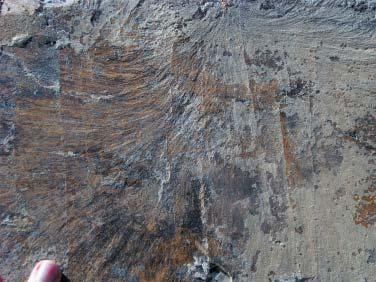
Figure1.7 Left :diagramoftheidealfractographyofanextensionfracture(adaptedfromKulanderandDean,1985).Fromthepointof origin(1),thefracturepropagatedbothtotheleftandtherightalongtheplumeaxis(3),leavingraysorplumebranches(2)thatdiverged fromthemainfractureplanenearthedistaledgeofthefracturetoformtwisthackle(4).Arrestlinesorribs(5)suggestincremental fracturepropagation. Right :asubtleplumestructureornamentsthefaceofanextensionfracture(paralleltotheplaneofthephotograph) inasiltstone.Theplumerecordsafracturethatoriginatedataninhomogeneityneartheupperedgeofthephotoandgrewboth downwardandlaterally.(Asetofyounger,narrow,closelyspaced,calcite-filledextensionfractures,strikingnormaltotheplaneofthe photographandmarkedbyfaintverticallines,intersectstheplumedfractureface.Theabsenceofinteractionbetweentheraysofthe plumeandthenarroworthogonalfracturessuggeststhattheplumedfractureformedfirst.)
inthesamecore,onewithapower-lawsizedistribution andonewithalog-normaldistribution.
1.3.3Fractography
Assessmentsoftheeffectsofanatural-fracturesystem onreservoirpermeabilitybeginwithidentificationof fracturetype.Thisinturnstartswithrecognitionof thedistinctivefracture-facemarkings,the fractography thatispresentonmanyfractures.Themarkingson shearfracturesareentirelydifferentfromthosefound onextensionfractures,andfractographycanbeused todifferentiatethesetwoprimaryfracturetypes(see Bahat,1979;Hancock,1985;Petit,1987;Kulanderetal., 1990;Ameen,1995;Doblas,1998).Fractographyforms asafractureinitiatesandpropagates,recordingsomeof theconditionsoffracturingandthedirectionoffracture propagation.Theinferencesderivedfromfractography weredevelopedinlargepartbyanalogytosimilarfeaturesfoundonthesurfacesoffracturesinmaterialssuch asglassandceramicsinthelaboratory(e.g.Kulander etal.,1979)
Althoughnotalwayspresent,fractographycanbe usedtohelpassessfracture-controlledreservoirplumbingsinceanextension-fracturesettypicallyconsistsof poorlyinterconnectedparallelfractureswhereasshear fracturescommonlyformasnetworksofconjugatepairs. Moreover,extensionfracturescommonlyformparallel andnormaltotheinsitustresseswhereasshearfractures aremorecommonlyobliquetothosestresses,impacting interpretationsofhowthefractureswillbehaveduringchangesinstresscausedbyreservoirproduction, aswellasthepotentialinteractionsbetweennatural fracturesandhydraulicstimulations(seediscussions
andexamplesinPart3).Wherefracturestrikedataare absent,fractographymayprovidetheonlyindicatorfor assessingfracturetypeandorientationrelativetothein situstresses.
Plumestructure(Figure1.7)isdiagnosticofextensionfractures,anditisbestdevelopedinfine-grained andwell-cementedrock.Someoftheearlyauthors suggestedthatplumesformonshearfractures,but mostrecentpublications,mostlaboratoryexperiments, andmostfieldevidencesuggestthatplumesformon extension-fracturefaces.WeinbergerandBahat(2008) suggestthatdifferentplumepatternscanformatdifferentratesoffracturepropagation,withwell-developed plumesformingduringrapidpropagation.Slowerpropagationrates,alongwithcoarse-grainedand/orpoorly cementedlithologies,mayprecludetheformationof plumesonextensionfractures.Plumescanalsobe obscuredbymineralizationorremovedbydissolution afterfracturing,sotheabsenceofaplumedoesnot excludeanorigininextension.
Plumestypicallyconsistofraysformingsystematic arcsthatdivergefromacentralaxisonafractureplane. Thecentralplumeaxisisoftenparalleltobeddingand locatednearthemiddleofabed,andthedivergentrays oftheplumerecordthedirectionoffracturepropagation.Plumeaxesmayalsobelocatednearertheupper orlowerbeddingsurfacesofalayeredrockratherthan themiddleofabed,ortheymayfollowbeddingplanes. Someplumeshavelessdefinitiveandlesslinearaxes, wanderingirregularlyacrossafracturefaceandsuggestingthatthefracturegrewunderconditionsofrelatively lowstressanisotropy.
Theparabolicribsorarrestlinesthatcommonlyalso occuronplumedfracturefacesaretypicallyinterpreted
astherecordofpausesinfracturepropagation,although morecloselyspacedWallnerlineswithsimilarshapes mayalsoformduetootherprocessesinvolvingpropagationratesandassociatedsonicwaves(seeFrechette, 1972;Kulanderetal.,1979).BothribsandWallnerlines areconcavetowardsthepointoforiginofthefracture, whichisoftenlocatedatanobviousflawintherocksuch asafossil,clast,orevenanolder,intersectingfracture.
Arrestlinesindicatethepositionofafracturefront whenthedrivingstressanisotropywastemporarily reducedbelowthatneededforfracturepropagation. Theycanalsoresultfromtheextravolumecreated withinthenewfracturewidthwhichreducedthelocal porepressure,makingtherocktemporarilylesssusceptibletofracturepropagationuntilthefluidpressures withintheaperturewasre-establishedandtherockwas againpronetofracturing.Arrestlinesdonotmarkcyclic injectionsofhigh-pressurefluidsintothefracture.
Twisthacklemayformatthedistaledgesofanextensionfracture,mostcommonlybeingfoundwherethe fracturehaspropagatedtoandterminatedagainsta bedconsistingofadifferentlithology.Thecommon interpretationoftwisthackleisthatthefractureplane changedorientationbyafewdegreesinazoneofslightly alteredstressesattheedgeofpropagation.
Shearfractureshaveawidervarietyoffractographic markings.Doblas(1998)listed61kinematicindicators forshearfracturesthatcanbecombinedinto11groups, butmanyoftheseindicatorsoccurinrockthatismore structurallydeformedthanthattypicallyofinterestto thehydrocarbonindustry.Themorelimitedlistoffractographicmarkingsthatarecommononshearfractures inreservoirsincludesslickensides,slickenlines,slickencrysts,andsteps,whilegougeandbrecciacandevelop alonglargershearfracturesandfaults.
Slickenlines formwhenthetwofracturefacesslidepast eachotherandtheirirregularitiesscorelinearpatterns ontheopposingfaces.Multiplesheareventsindifferent directionsmayberecordedbysuperimposedoblique slickenlines,theyoungestobscuringorevendestroying olderlineations.Asinglesetofslickenlinesindicates twopossibledirectionsfortheshearoffset,andthe180∘ ambiguityusuallycannotberesolvedwithoutcorrelation pointsacrosstheshearplane.
Slickensides (Figure1.8)arecreatedwherelarger magnitudesofshearoffsetand/orhighermagnitudesof compressivestressnormaltothefractureplaneduring shearcreatealayerofcomminutedrockonthefracture face.Thelayerofcomminutedrockandthefractureface mayevenhavebeenmetamorphosedbythehighpressuresandlocalhightemperaturescreatedduringshear, reducingpermeabilityacrossthefractureplane.Slickensidesmayalsobemarkedbycuspatechatter-marks orotheroftheshearmarkingsillustratedbyDoblas
Figure1.8 Accretionary,congruentstepsformedofcomminuted hostrockandlighter-coloredcalcitemineralizationornamentthe faceofthisshearfracture,indicatingthatthepicturedblock movedtotheviewer’srightandthemissingblockmovedtothe leftonastrike-slipshearfracture.Themagnitudeofoffsetcannot bedetermined.Handleofapocketknife,left-center,forscale.(For anotherexampleofslickensidesseeFigure3.4.)
(1998),andthelayerofcomminutedrockmayform accretionarystepsonthefracturesurface.Theshort, abruptrisersofthestepstypicallyfacethedirectionof offset(“congruentsteps”;Hancock,1986;Petit,1987) andtherisersstrikenormaltotheslickenlinesfoundon thelongertreadsofthesteps,althoughGay(1970)did experimentalworkthatsuggestedaccretionarystepson slickensidedfracturefacescanbeasymmetricineither direction.
Shear,especiallyincarbonatesandespeciallywhere therewasasignificantcompressivestressnormaltothe fractureplaneduringshear,cancauseminordissolution ofthehostrockadjacenttotheshearplane.Dissolutionisevidentfromthethinfilmsofinsolubleresidue thatlinethefacesofthesefractures(seeFigure2.27). Theprocessissimilartothatwhichproducesstylolites butwithtypicallysmalleramountsofdissolution,and shearpreventstheformationofstyloliteteeth.Aswith theresiduesthataccumulatealongstylolites,insoluble residuesonshearplanescanbebarrierstoflowacross thefracturefaces.
Shear-fracturesurfacesinmudstonescanbeshiny, seeminglypolished,andslickenlined,sinceshearmotion alignstheclayplateletsintherockparalleltothefracture
face.Suchsurfacesshouldalsoinhibitpermeability normaltothefractureplanealthoughtheeffectmaybe lessimportantsincethematrixpermeabilityofmudrocks islowtobeginwith.
Shearfracturesmaybemineralizedaftershearhas takenplace,soundeformedcrystallinemineralization withnoevidenceforsheardoesnotprecludeaninterpretationofafracturesetasoriginatinginshear.On theotherhand,themineralizationitselfmayshowevidenceforshearinseveralforms.Mineralizationmay preserveanimpressionoftheslickensidedorslickenlinedfracturefaceonwhichitwasprecipitated,orthe mineralizationitselfmayhavebeenshearedbyoffset whileorafteritwasbeingprecipitatedinthefracture aperture.Inthecaseofmultiple,concurrenteventsof
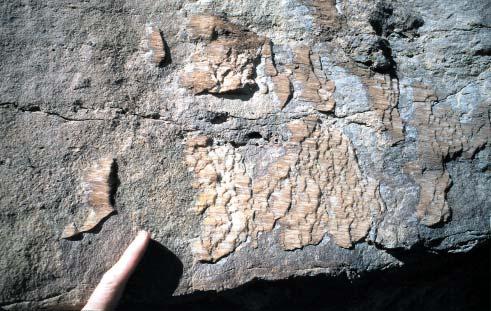
shearandmineralization,multiplelayersofmineralizationarecommonlytruncatedandlens-shapedin crosssectionscutnormaltothefractureplane.Slickencrysts(asymmetric,crystallinedeposits),mayform withanasymmetricfish-scalepattern(seeLorenzand Cooper,2018a)whensmall-magnitudesofshearoffset areconcurrentwithmineralprecipitation(Figure1.9). Evidenceforsmall-scaleshearoffsetisimportant, especiallywherethesamplingofafracturepopulation issmallortruncatedasfromacoreoranimagelog, sinceshearfractureswithevenmillimeter-scaleoffsets canformasnetworksofintersectingconjugatepairs, creatingpermeabilitysystemsthataredistinctlydifferent fromthoseformedbyfracturesetsconsistingofparallel extensionfractures.Small-scalesheariscommonly


Figure1.9 Steppedshear-fracturefaces. Topleft :asymmetriccalciteslickencrystsmarkedbyslickenlinesweredrawnoutbystrike-slip shearbetweenthefacesofthisshearfracture.Thepicturedblockmovedtotheviewer’sleftandthemissingblockmovedtotheright. Topright :non-congruentshearstepsornamentthefaceofthisnormaldip-slipshearfracture,partofapairofdip-slipconjugateshear fractures.Asimilarnon-congruentsteppedfractographywasproducedexperimentallybyPaterson(1958)onshearfracturesinthe laboratory.Thestepsarecomposedofunalteredhostrockandindicatethatthepicturedblockmoveddownwardwhilethemissingblock movedupward,againsttheapparentstepasymmetry.Beddingoffsetsshowthatthemagnitudeofshearoffsetwasontheorderofa millimeter.Theshortrisersonthesestepsformedasconnectorsbetweenthefracturesegmentsthatformthesteptreadswhentherock brokealongtheshearplaneduringroadconstruction. Bottom:avertical,strike-slipfractureornamentedwithsmallnon-congruentsteps similartothoseshownintheupperrightphoto,butwithanorientationthatindicatesminimalleft-lateraloffset.Thehighpointsofthe stepsareslickenlined,havingbeenmodifiedbyasmallamountofadditionalshear.Continuedleft-lateraloffsetwouldhavedestroyed thesestepsandcreatednewoneswithareversedasymmetryoutofcomminutedrock.
recordedbyasymmetricsteps,superficiallybutmisleadinglyresemblingthosecreatedoutofcomminutedrock onslickensidedfracturefaces.Thesestepsconsistof unalteredrock,andthelongtreadsofthestepsaresmall enechelonfracturesthatformedalongandwithinanarrowzoneofshear.Theabruptrisersthatconnectthese treads,non-intuitivelyfacing away fromthedirection ofoffset(“non-congruent”steps),arecreatedwhenthe rockbreaksopenalongtheshearzone,connectingthe enechelonsegments.Small,sometimeslunatestepsmay bescatteredacrosssuchfracturefaces.Thehighpoints ofthestepsmaybesecondarilyslickenlinedifshearcontinues,butshearofanysignificantmagnitudeconverts thestepstocomminutedrock,formingaccretionary stepswiththeopposite,“congruent”senseofasymmetry relativetothedirectionofshear.
Incontrasttotheseindicatorsofsmallshearoffset, gougeandbrecciaindicateshearfractureswithlarge offsets.Antitheticshearfracturesorientedobliquetothe shearplanemayevenformasashearfracturegrowsto becomeafault.
AsdescribedbyAndersonasearlyas1905,shearfracturefractographywillrecordnormaldip-slip,reverse dip-slip,orstrike-slipoffset(dependingonwhichofthe threeaxeswerethemaximum,minimum,andintermediatestresses)intheidealconditionwherethethree compressivestressesareverticalandhorizontal.However,manyshearfracturesshowrakingslickenlinesthat recordobliqueslip,havingformedinmorecomplex stresssystemsorwherethestresssystemchangedafter fracturingandtheshearplanewasreactivatedwithin thereorientedstressfield.Reorientedstressfieldscan developasafoldtightensorasafoldmigratesthrough aformation,andrakingshearsmaybeexpectedwithin suchstructurallycomplexsettings.Idealshearfractures canalsobetiltedwithbeddingduringpost-fracture deformationsothatthefractographyrecordsraking offsetrelativetothepresentorientationofthefracture.
1.3.4FractureDipAngles
Fracturedipangleisasimple,easilyunderstoodcharacteristicinnon-complexstructuralsettings.Most extensionfracturesareverticalornearlyso,sincethey formintheplanedefinedbythemaximumandintermediatecompressivestressesandsincethevertically actingweightoftheoverburdenprovidesthemaximumcompressivestressinsuchsettings.Mostvertical extensionfracturesarenormaltobedding,notbecause beddingcontrolsdipbutbecausebeddingiscommonly horizontal.
Topographicreliefandstructuralcomplicationscan createstresssystemsthatareinclinedrelativetoverticalwhichcanresultininclinedextensionfractures
withintermediateorevenlowdipangles.Inclined extensionfracturesmayalsohaveoriginatedasvertical, bed-normalplanesthatlaterbecametiltedalongwith beddingduringfolding,andbed-normalbutnon-vertical extensionfracturesmayformduringfoldingdueto extensionontheoutsideofcurvature(Figure1.10). Occasionallyfracturesthatareinclinedrelativebothto verticalandtobeddingformduringfoldingofalayered formationwherebed-parallelshear(flexural-slip)atthe sedimentarycontactsaboveandbelowafracturedbed setsupalocalbedding-obliqueextensionalstresssystem.
Mostextensionfracturesareplanar,buttheplanescan becurvediftherockwasbeingtwistedasitfractured. Extensionfractureswithplumemarkingsoncurved facesoccurwithinstrike-slipstructuralsettingswhere impingementsatasperitiesandvariationsinthrowalong irregularfaultscreatecomplexstressconditionsthat changeduringfaulting.
Theidealdipanglesinsimplestructuralsettings, describedbyAnderson(1951),areverticalforstrike-slip shears,60∘ fornormaldip-slipshears,and30∘ forreverse dip-slipshears(Figure1.3).Intermediate-angle,hybrid extension-shearfracturescanformasconjugatepairs inanyofthethreeconfigurations,buttheintersection anglesarelessthanthe60∘ idealangle(Hancock,1985). Inthelaboratory,theacuteconjugateintersectionangle forconjugateshear-fracturepairsdecreasesastheconfiningpressureontherockdecreases(e.g.Paterson, 1958).Theconjugatepairsofnormalandreversedip-slip shearshaveparallelstrikesandopposingdipdirections, ausefulrelationshiptorememberwhenreconstructing fracturesystemsfromtheone-dimensionalsamples affordedbycoresandimagelogs.
Aswithextensionfractures,shearplaneswith non-idealdipanglescanalsoformwherethestress systemisinclined,asincomplexstructuralsystems,and canbefoundwherethestratawerefoldedortiltedafter fracturing.Thedipanglesofshearfracturesthatcut acrossmultiplelithologicunitscanchangeduetovariationsinthemechanicalpropertiesbylayer(Figure1.11). Finally,certainkindsofextensionandshearfractures canhavehorizontaldipangles,commonlyparallelto bedding,asdescribedinSection1.5,“OtherFracture Types.”
1.3.5FractureDistributions
Fracturesinheterogeneousformationsaredistributed neitheruniformlynorrandomly,sostochasticmodels predicatedonrandomorprobability-basedfracture distributionsmakelessthanfulluseofgeologicdataand theory(e.g.LoosveldandFranssen,1992).Fracturesystemsoccurindomainswherethefractureshavesimilar characteristics,anddomainscanvarylaterallyaswell
Figure1.10 Top:bed-normal,inclinedextensionfracturescan formduetoextensionoftheouterlayersofstratainafold(the layerisnotintension,butrathertheminimumcompressivestress σ3 isreducedtoformastressanisotropylargeenoughtobreakthe rock),andtheycanformasverticalfracturespriortofolding, becomingtiltedasthestratafold. Middle:morerarely,extension fracturesthatareinclinedrelativebothtoverticalandtobedding canformonafoldduetoobliqueextensionwithinabedbetween twobed-parallelshearzones. Bottom:anoutcropexampleofthis typeofextensionfracturing(paralleltotheblacklines)intilted limestonesoftheEocenePilaSpiFormationinnorthernIraq.
asvertically.Straincanbeaccommodatedbydifferent fracturetypesinthedifferentlithologiesofaheterogeneousformation,called“strainpartitioning.”Fractures aretypicallymorecommonin,andcanevenbelimited to,themorebrittlebedsofaformation(Figure1.12); ifallunitsarefractured,extensionfracturesmaybe morewidelyspacedinthemoreductilebedsthanin thebrittlebeds,ortheductileunitsmaycontainshear fractureswhileextensionfracturesoccurintherelatively brittlelithologies(e.g.Lorenzetal.,2002;Lorenzand Cooper,2018b,2018c).
Theruleofthumbthatfractureintensityisafunction ofductility/brittlenesscanbeuseful,butbedsthatare brittletodaywouldnotnecessarilyhavebeenbrittleduringstraineventsthatoccurredinthegeologicpast.The fracturesusceptibilityofrockcanchangeovertimedue todiagenesis,cementation,burialdepth,temperature, compaction,porepressure,confiningstress,andstrain rate.Anextensivebutproprietaryfracturedatabase compiledfromcorecutfrommarinestratashowsthe presenceofthreeextension-fracturesetswithdifferent strikesinareservoir:onefracturesetisrestrictedto thedominantmudstones,onesetisrestrictedtothe interbeddedlimestones,andonesetcutsindiscriminatelyacrossbothlithologies.Thissystemofthree fracturesetsrecordsanevolutioninthemechanical propertiesandrelatedfracturesusceptibilityofthethree lithologiesduringthecourseofthreeseparatefracture events.
Inanotherexample,acoarse-grainedarkoseoftheAbo FormationinNewMexicoiscutbyanearlysetofnormal dip-slipconjugateshearfractures,andayoungersetof extensionfracturesthatstrikenearlynormaltotheshear fractures.Thesetwofracturesetsrecordachangeinrock propertiesand/orthestressconditionsbetweenthetwo fractureevents(LorenzandCooper,2018b).
Sincemechanicalpropertiescanvarybylithology, themechanicalstratigraphythatcontrolsfracturingin manysedimentaryformationscorrelatestoconventional stratigraphy.Inmoreheterogeneousformationsan irregularmechanicalstratigraphymaycontrolasimilarly irregularfracturedistribution.Wherethemechanical contrastsbetweenunitsofaheterogeneousformation arelow,forexamplewhereallunitsareheavilycemented regardlessofgrainsizeorcomposition,theymayform anoverarchingmechanicalunitcomposedofmultiple sedimentaryunits,andfracturesmayextendacrossthe otherwiseheterogeneouspackage(Figure1.13).
Fracturedistributionandintensitydependnotonly onlithologybutalsoonstructuralsetting.Forexample, extensionfracturesmaybemorecloselyspacedalong themoreabruptlyfoldedhingeofananticline,where percentstrainwashigherthanontheflanksofthefold. Similarly,shear-fractureintensitycommonlyincreases
Figure1.11 Fracturedipangles: Left :histogramofthenon-idealdipanglesof23strike-slipshearfracturessampledbyahorizontalcore (unpublisheddata). Right :theeffectoflithologyondipangle:aninclineddip-slipshearfractureincorebecomessteeperwhereitcrossesa layerofstifferrockina4-inch(10-cm)diametercore.Fracturescantransitionfromextensionfracturestoshearfracturesandbackagainto extensionfracturesastheyextendfromonebedtoanotherinaheterogeneouslithology.


Figure1.12 Left :thefrequencyofextensionfracturesbylithologyfrom4,200ft(1280m)ofverticalcorefromtheCretaceousMesaverde Formation,Colorado.Sixty-eightpercentofthe274coredfracturesoccurinsandstones,whichcompriseonlyabout30%ofthecored section,suggestingthatthesandstonesareintenselyfracturedcomparedtothemudstones,whichcontainonly4%ofthecoredfractures butcomprisesome50%ofthesection(fromFinleyandLorenz,1988). Right :short,strata-boundfracturesthatarerestrictedtothe limestonelayersinathin-beddedlimestone-marlsequence(CretaceousTwinBridgesFormation,shallowmarine,NewMexico).
nearfaults,particularlyinthehangingwallsofnormal dip-slipfaults(Figure1.14)(e.g.Nelson,2001;Withjack etal.,1990).Fractureintensityincreasesbothwiththe brittlenessofthestrataandwithpercentstrain,soitcan bethoughtofasfittingintoadiagramwherebrittleness increasesononeaxisandwithdegreeofdeformation ontheotheraxis:fracturingshouldbebestdeveloped inbrittlerocksnearafaultandleastwelldevelopedin ductilestratadistantfromafault.
GrossandEyal(2007)describedafieldexamplefrom afolded,heterogeneous,layeredcarbonateformation thatillustratesthecombinedeffectsoflithologyand strain.Themoreductilelayersonthebroadfoldarecut bystrata-boundshearfractureswhereasstrata-bound
extensionfracturesformedinthemorebrittlelayers. Withincreasingstrain,thefracturescoalesceintofractureswarmsandfaultsthatcutacrossalllithologies (Figure1.15).
Turcott(1986)wasamongtheearlyauthorstodescribe natural-fracturedistributionsasfractal,i.e.thatthedistributionsoffracturedimensionsaresimilaratnumerous scalesofobservation,andfractalfracturedistributions havebeenreportedfromoutcrops(e.g.Lietal.,2018). However,LoosveldandFranssen(1992)suggested theremaybedistinctionsbetweenthedistributionsof extensionandshearfractures,citingpublisheddata fordeformation-bandshearfracturesthatarefractally distributedanddocumentingextensionfracturesintwo
Figure1.13 Left :parallel-strikingextensionfractureswithirregularheightsandspacingshaveanirregulardistributioninaheterogeneous fluvialsandstone.Somefracturesareverticallythrough-going,othersarelimitedbysomeoftheinternalbeddingplanes(Cretaceous MesaverdeFormation,Colorado). Right :tallextensionfracturescutverticallythroughsome120ft(40m)ofhomogeneouseolianquartz sandstone(PermianCoconinoSandstone,Arizona).
DISTANCE(km)
Figure1.14 Left: Withjacketal.(1990)documentedtheenhancedfracturingthatformsaspartofafault-relatedprocesszoneintheir experimentalmodels.Mostofthefracturesforminthehangingwall.(ReprintedfromWithjacketal.,1990,withpermissionfromAAPG, whosepermissionisrequiredforfurtheruse). Right :asubsurfacefracturemodelbasedonoutcropstudiesacrossa7.5mile(12km) transectinanormallyfaultedterraneintheTalaraBasin,Peru,highlightstheexpectedincreasesinfracturedensityandconcentrationin thehangingwallnearnormalfaultsinanextensionalsetting(adaptedfromRoldanetal.,2013). well-exposedoutcropexamplesthatarenot.Odlingetal. (1999)alsoreportedthatthesizesofshearfractures, butnotstrata-boundextensionfractures,are“often” fractallydistributed.
Tobetrulyfractal,allfracturedimensionsshould followthefractalpattern,sothisconceptmaynotapply tofractureswherevariousdimensionswerecontrolled bydifferentprocesses.Forexample,extensionfractures heightsandspacingsarecontrolledinpartbybedding thicknesswhereaswidthandlengtharecontrolled largelybypercentstrain.Moreover,whereasafractal fracturedistributionmightdevelopinahomogeneous system,thepresenceofstructuralorlithologicheterogeneitiessuchasapre-existingfracturesetorastrong crossbeddingfabricintroduceslocalcontrolsonfracture distributions,sotheconceptmustbeusedcarefully.
1.3.6FractureHeightsandTerminations
Fracture-heightdataprovideinsightsintothevertical continuityandinterconnectivityofafracturesystem withinandbetweenreservoirs.Unfortunately,many subsurfacefracture-heightdatasetsareseverelytruncatedsince“vertical“fractureplanesarenotalways orientedparalleltotheaxisofaverticalwellboreorcore, thusthefracturesmayexitacorebeforeterminating (Figure1.16).Horizontalwellboresandcorescapturean evensmallerpercentageofafractureset’sfullvertical heightdatasincemostfractureheightsexceedthediameterofthewellboreorcore.Wherecompletefracture heightsarenotcaptured,thepartial/minimumfracture heightsthatcanbemeasuredofferinsightsintothepopulationofheightsinafracturesystem,especiallywhen
